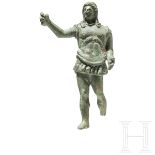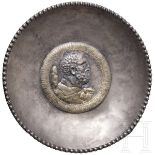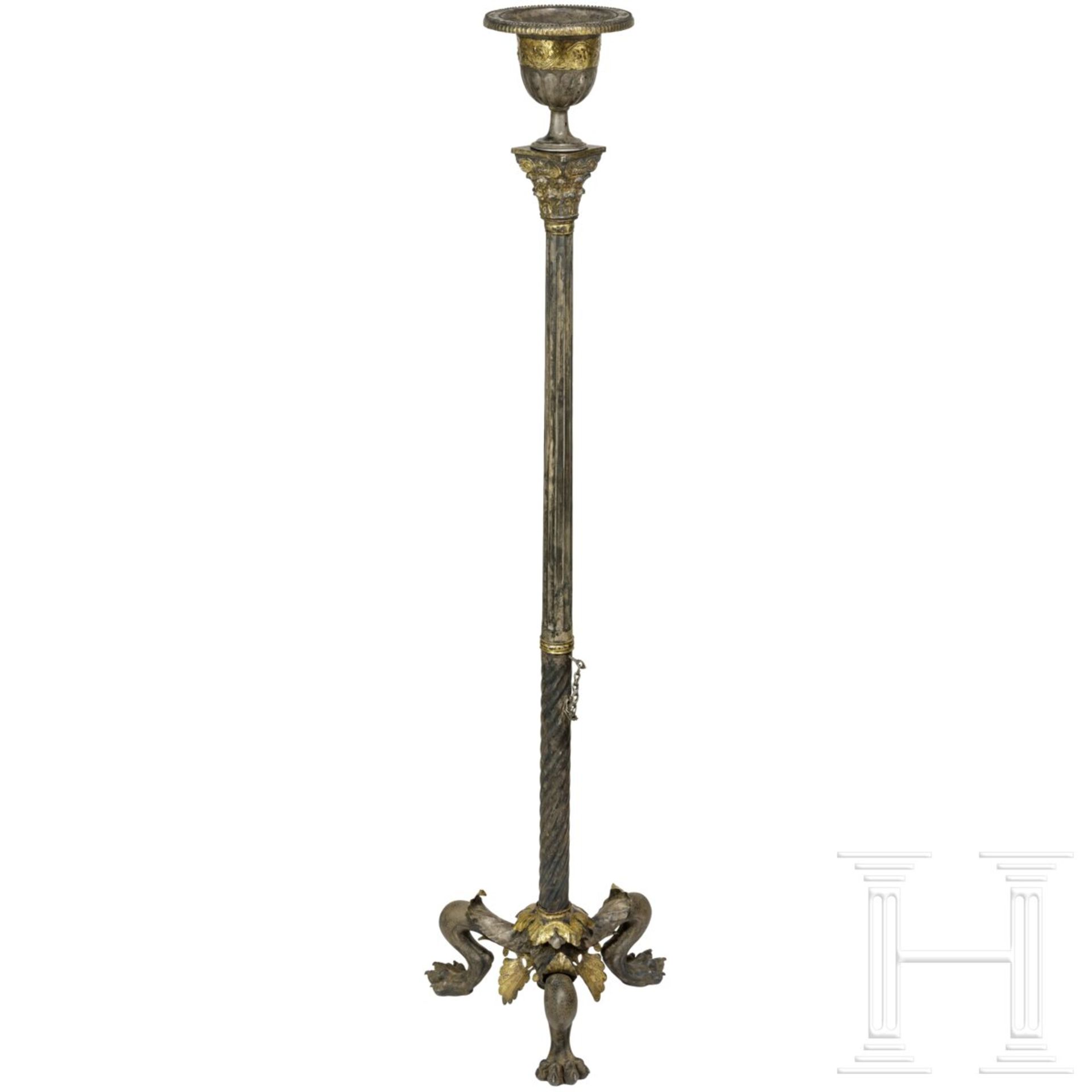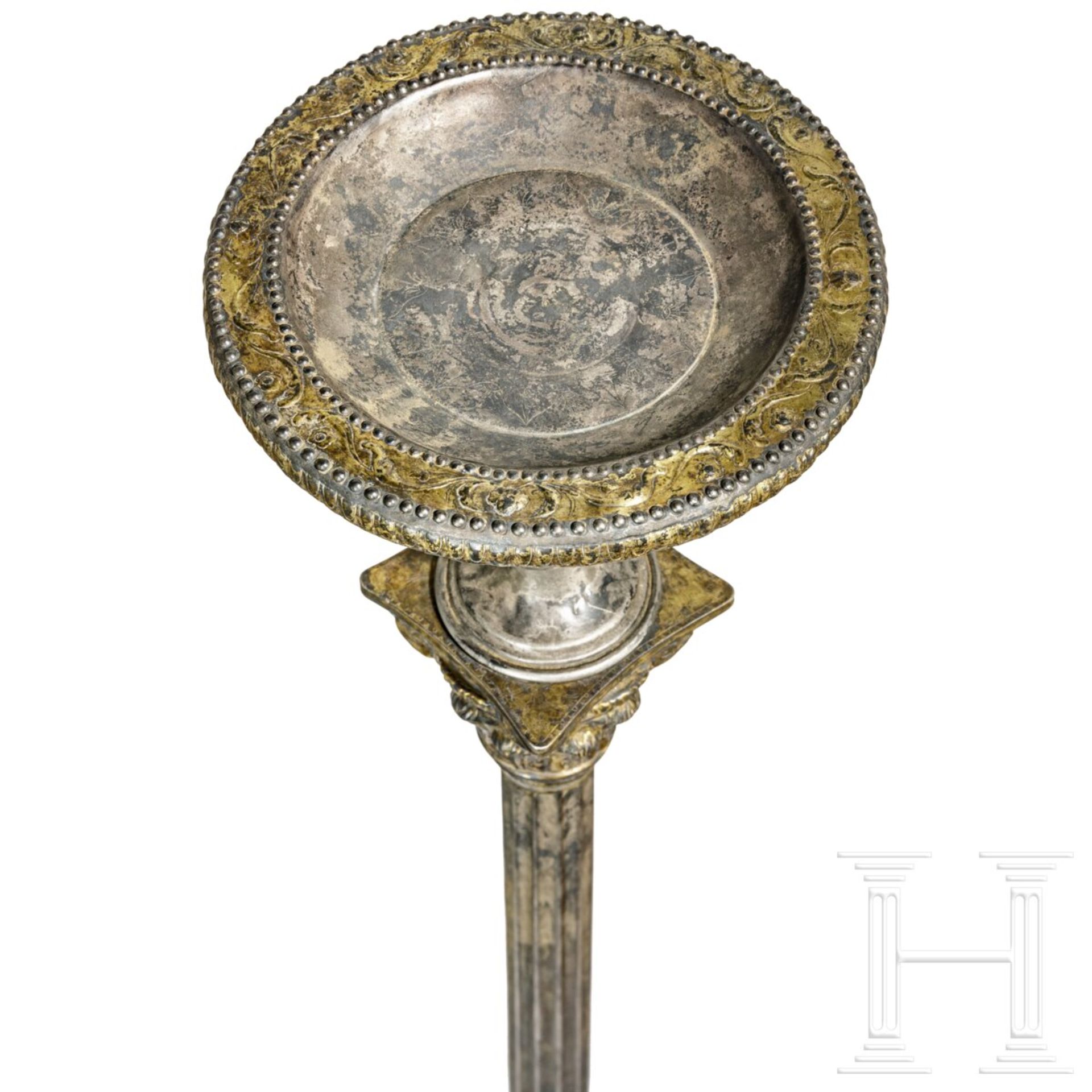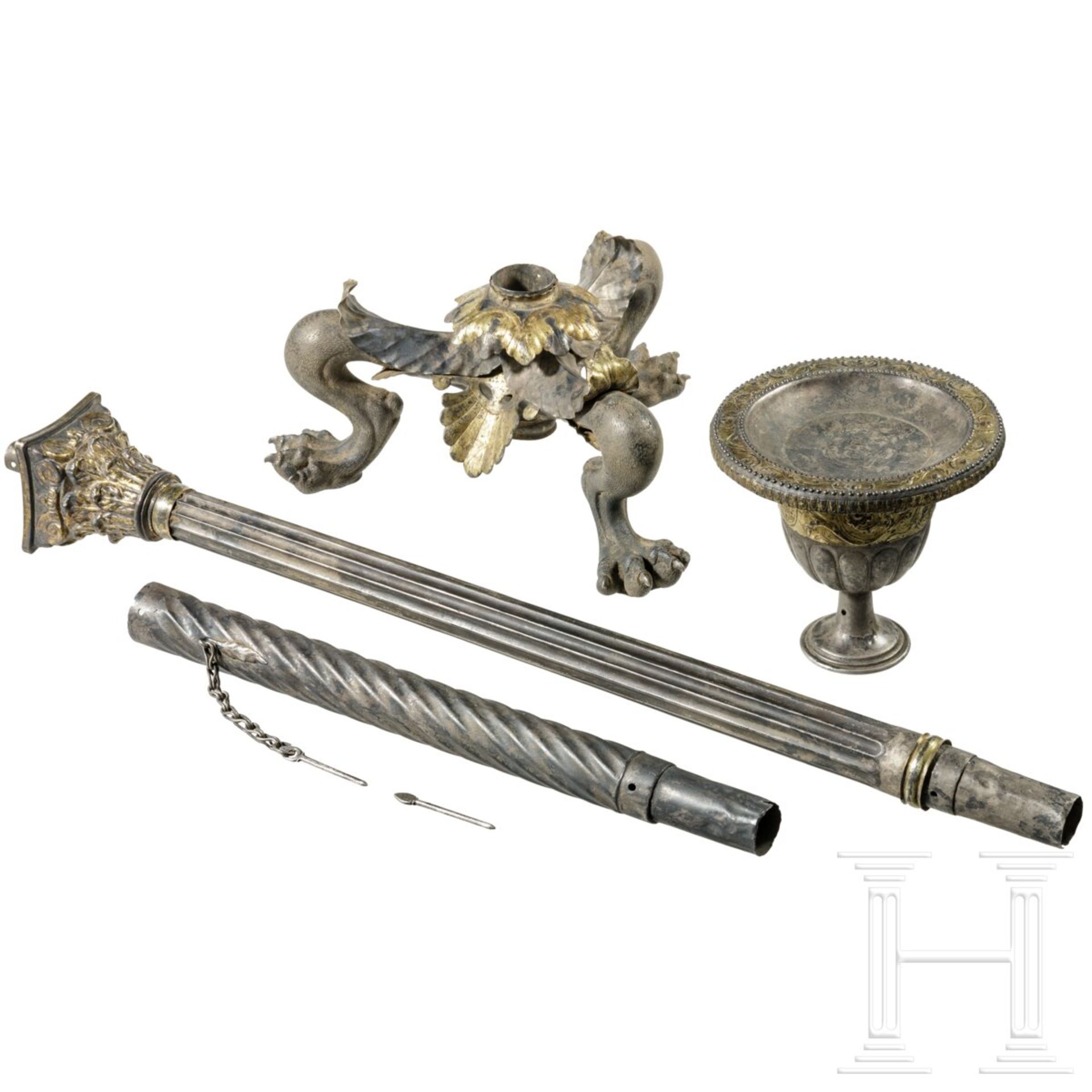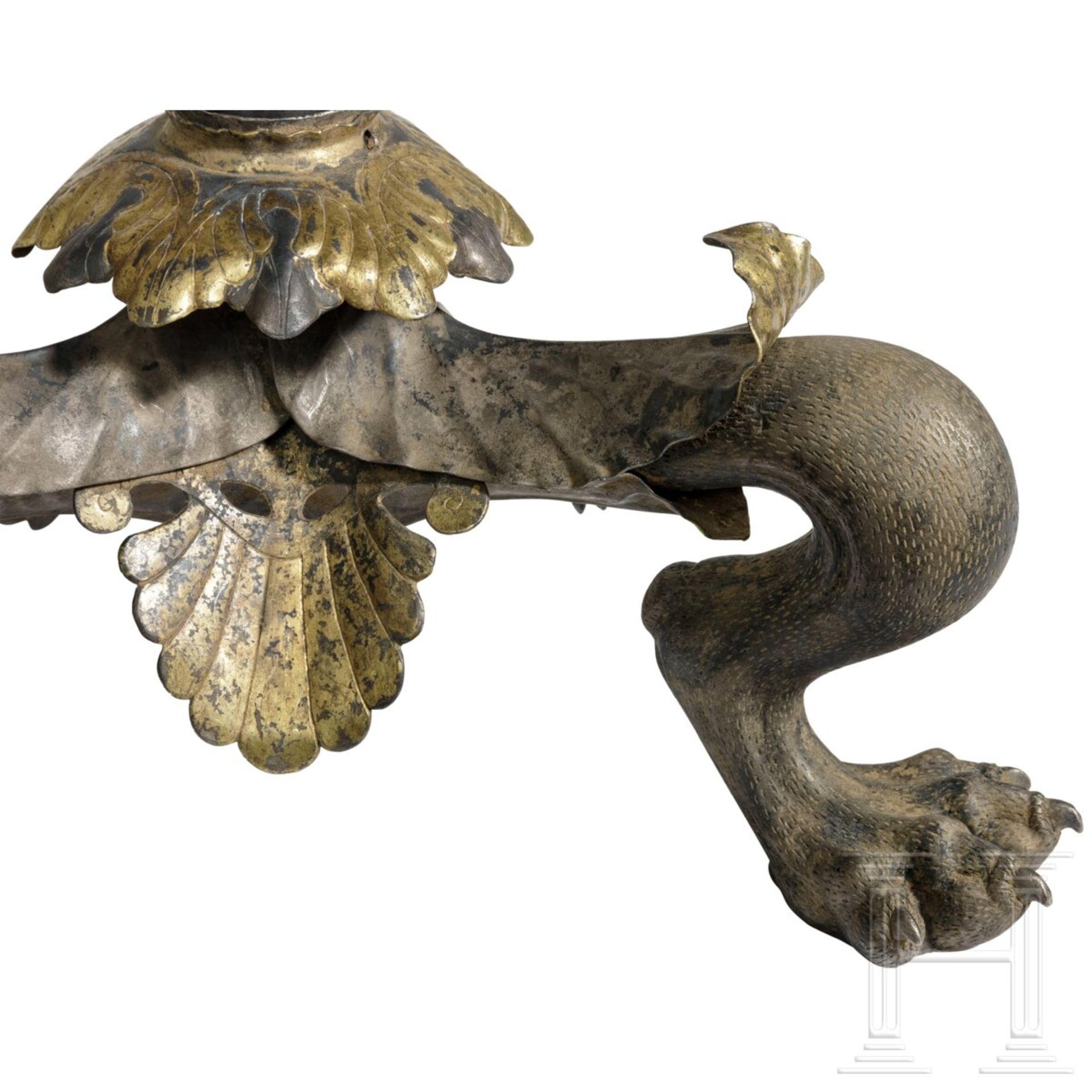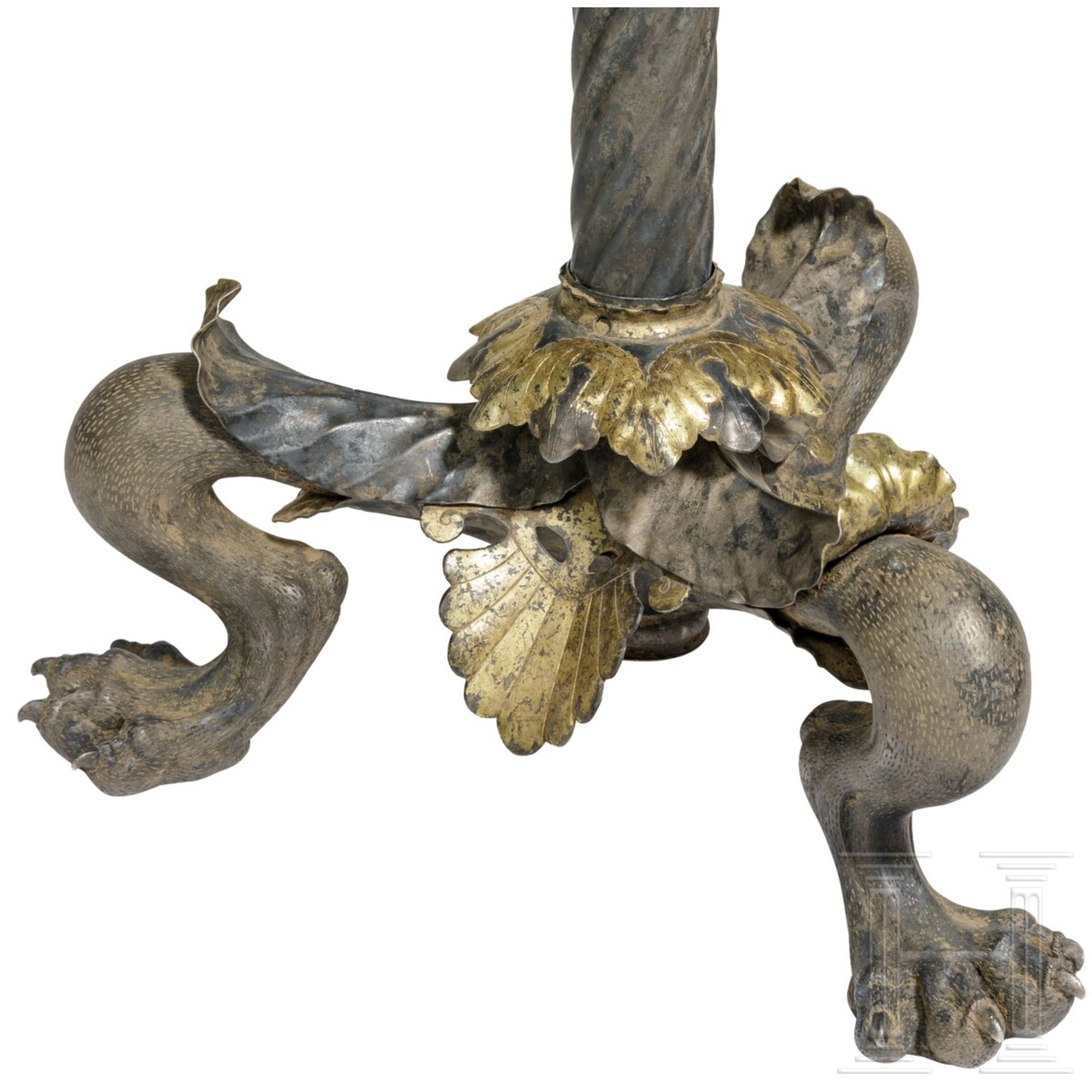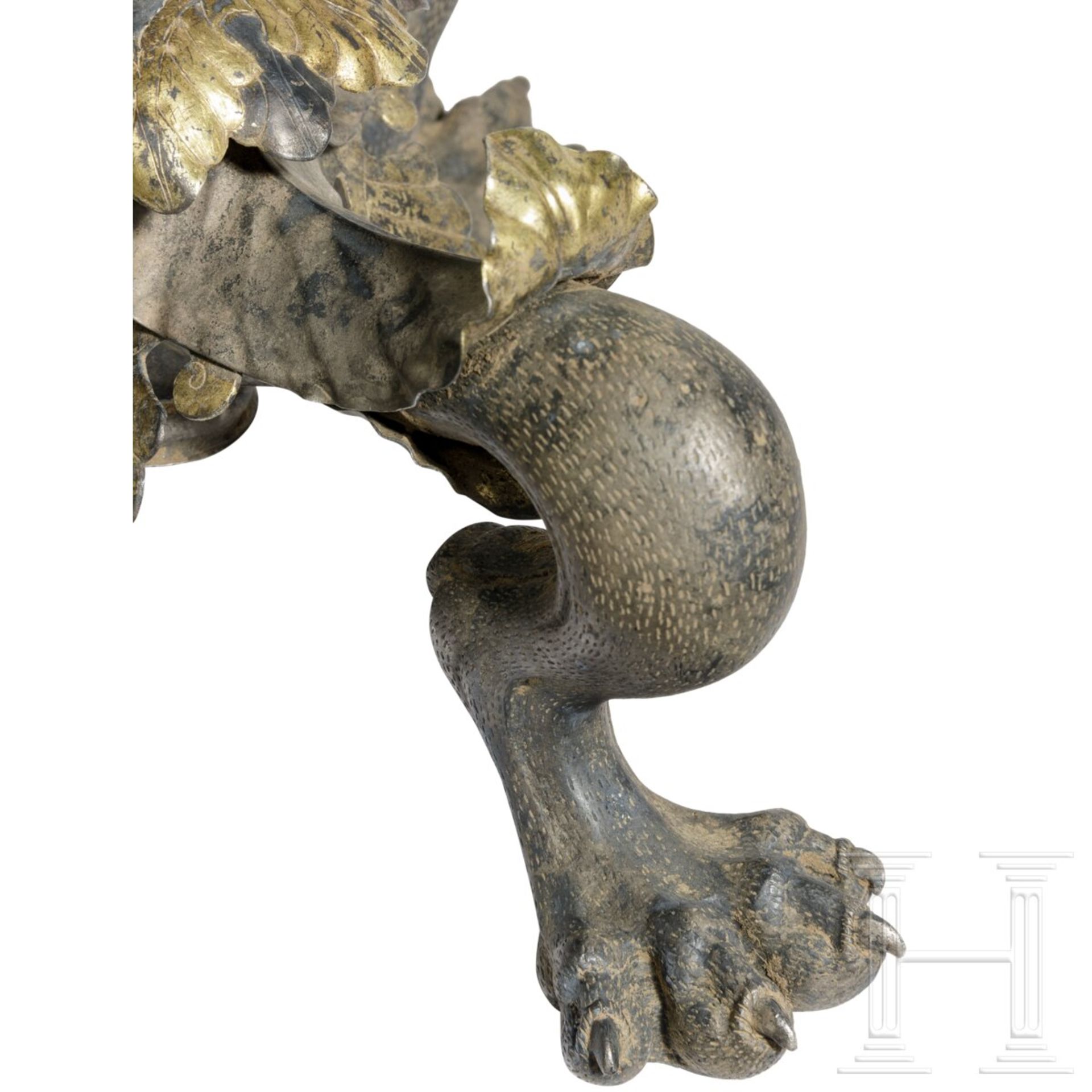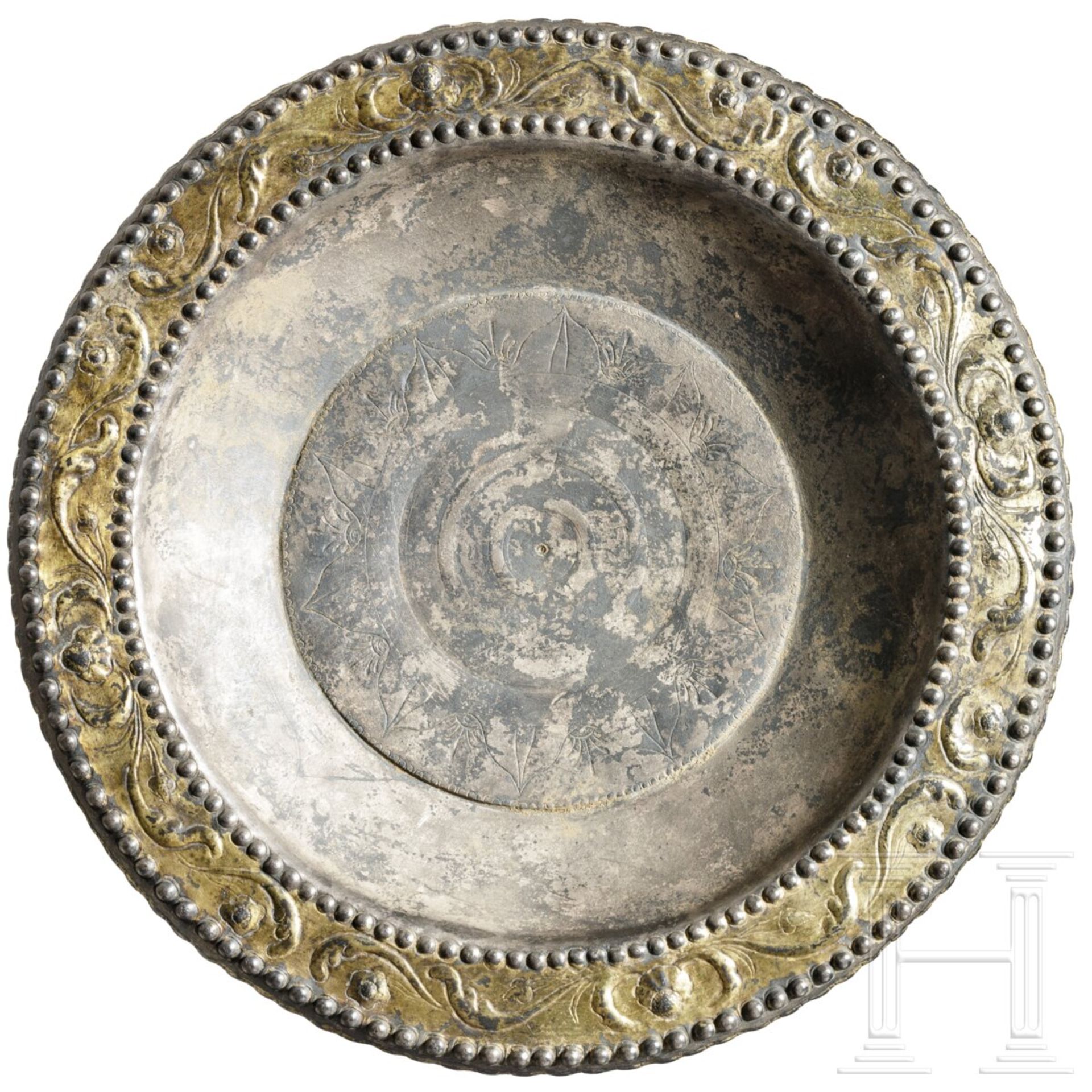38
Silberner Kandelaber augusteischer Zeit, 1. Jahrzehnt v. Chr. - 1. Jahrzehnt n. Chr.
Mehrteiliger Kandelaber von außergewöhnlicher Qualität und äußerster Seltenheit. Aus folgenden Einzelteilen zusammengesteckt und zerlegbar: 1) Massiv gegossener Fuß mit Blechappliken. 2) Unterer Säulenschaft aus Silberblech. 3) Oberer Säulenschaft mit Kapitell aus Silberblech. 4) Aufsatz aus Silberblech in Form eines Pokals mit Standfläche für eine Öllampe. 5) Loser Stift zur Fixierung.
Der Fuß verleiht dem Kandelaber mit den hohl gearbeiteten Oberteilen Stabilität. Drei massiv gegossene Raubkatzenpranken sind zur Mitte hin zusammengeführt und an einer zentralen, zylindrischen Röhre aus kräftigem Silberblech befestigt. Die künstlerische Qualität der naturalistisch geformten Pranken ist außerordentlich und bildet die anatomischen Einzelheiten bis ins kleinste Detail präzise ab. Die Ballen unter den Zehen, die Krallen und die Sehnen auf der Oberfläche der Pranken sind minutiös ausgearbeitet und an der Oberfläche fein und nuancenreich modelliert. Das Fell ist liebevoll und in äußerst gleichmäßigen, geringen Abständen durch Strichpunzen dargestellt. Die auf diese Art gestalteten Pranken und die dynamische Biegung der Läufe oberhalb davon erwecken die Assoziation einer vor Kraft strotzenden und zum Sprung bereiten Großkatze.
Zur Mitte hin sind die Läufe oben und unten durch gleichfalls äußerst naturalistisch gestaltete Blätter mit fein nuancierter Binnenstruktur abgedeckt. In den Zwischenräumen zwischen den Füßen drei wohlgeformte Blechpalmetten mit Durchbruchsarbeit. Direkt unterhalb der Mündung des zentralen Blechzylinders eine Manschette mit rundum verlaufendem Blattdekor. Manschette, Innenseite der Blätter und Palmetten vergoldet. Der zentrale Blechzylinder unten mit einer am Rand profilierten Kappe abgedeckt, auf deren Unterseite ein kräftig eingeritzter Namenszug im Nominativ: "VITVS OPTIMVS".
Gegenüberliegend einige schwächere Ritzungen, die möglicherweise als Gewichtsangaben zu deuten sind.
Breite von Fuß zu Fuß ca. 29 cm. Gewicht 2,22 kg.
Das zweite Teil ist eine präzise geformte Säule mit spiralig verlaufenden Kanneluren, die kurz vor dem glatten, oberen Rand durch Ritzlinien begrenzt sind. Im oberen Rand zwei Löcher zur Fixierung des folgenden Aufsatzes mit einem Stift. Dieser Stift ist mit einer Silberkette an einer blattförmigen Attasche befestigt, die auf dem Korpus der Säule festgelötet ist. Eine senkrecht verlaufende Naht lässt erkennen, wo das zur Röhre bzw. zum Säulenschaft gebogene Silberblech verschweißt worden ist. Der untere Rand gleichfalls glatt. Von den Kanneluren durch einen feinen Absatz getrennt. Dort wiederum zwei Löcher, deren Lage mit den oberen korrespondiert. Unten eine weitere Blechröhre eingesetzt und verlötet, die beim Zusammenstecken mit dem Fuß vollständig verschwindet, aber die Stabilität der eingesteckten Säule garantiert. Im Rand der Manschette unterhalb der Mündung des Blechzylinders im Fuß gleichfalls zwei Löcher, durch die ein Stift durch Säuleneinsatz und Blechzylinder in den Fuß geführt werden kann und zusätzliche Stabilität verleiht. Höhe des unteren Säulenschaftes 38,7 cm. Gewicht 316 g.
Der obere Säulenschaft unten ähnlich konstruiert wie der untere. Oberhalb der zwei Löcher zur Fixierung mit dem unteren Säulenschaft zusätzlich eine profilierte, vergoldete Manschette. Die Säule selbst diesmal mit senkrechten Kanneluren versehen. Oben wieder durch eine gleichartige Manschette abgeschlossen und darüber mit einem in allen Details fein ausgearbeiteten und wohl proportionierten korinthischen Kapitell abgeschlossen, das gleichfalls aus getriebenen Blechteilen zusammengefügt worden ist. Oben eine rechteckige Platte mit leicht eingezogenen Seiten, in deren Mitte ein schmaler Blechzylinder mit zwei Löchern steckt, der zur Aufnahme und Fixierung des letzten Teils dient, dem "Pokal" mit Standfläche für die Öllampe. Höhe dieses Segments 66,5 cm. Gewicht 650 g.
Der Pokal unten mit einem Stiel, der in eine am Rand profilierte Standfläche übergeht. Die Unterseite durch ein Blech mit zentralem Loch abgedeckt, durch das der Blechzylinder auf dem korinthischen Kapitell gesteckt werden kann. Im Stiel zwei Löcher zur Sicherung des Pokals mit einem Stift. Der Körper des Pokals in zwei Zierzonen eingeteilt. Unten vertikal verlaufende, gewölbte und am Rand markant ziselierte Zungen. Darüber ein vergoldeter Fries mit einer Wellenranke. In den Wellentälern und -bergen Blüten an abzweigenden Ranken. In den Zwischenräumen füllen feinere Ranken und Blätter die Felder. Die Standfläche mit einer tellerartigen Vertiefung. Der Boden durch Drehrillen in Zonen gegliedert, deren äußerste mit floralem Ritzdekor und Kreispunzen am äußeren Rand verziert ist. Der breite horizontale Rand durch zwei kräftige Perlkreise begrenzt, in der vergoldeten Bahn dazwischen wieder eine Wellenranke mit Blättern und Blüten. Auf der vertikal nach unten überhängenden Randlippe ein lesbisches Kymation. Höhe 14,1 cm. Durchmesser 15,7 cm. Gewicht 389 g.
Die Wellenranken auf dem Rand und der oberen Zierzone des "Gefäßkörpers" haben exakte Entsprechungen in Kunstwerken des augusteischen Zeitalters, wie der Ara Pacis in Rom oder anderem Silbergeschirr gleicher Zeitstellung, etwa dem Hildesheimer Schatzfund oder dem Depot von Boscoreale. Es besteht kein Zweifel, dass der Kandelaber als ein raffiniert konstruiertes und künstlerisch repräsentatives Meisterwerk der augusteischen Klassik angesehen werden darf. Vergleichbare Kandelaberformen aus Bronze, wenngleich nicht so vollkommen und nicht in diesem Maße zerlegbar, stammen aus Pompeji. Die Grundidee eines zerlegbaren Kandelabers mit ähnlichem Pokal und einem Kapitell findet sich noch Mitte des 4. Jhdts. im Schatzfund von Kaiseraugst, dort aber eindeutig mit Verzierungselementen der Spätantike.
Die Höhe des zusammengesteckten Kandelabers beträgt 114,5 cm, das Gesamtgewicht 3,58 kg. Von ursprünglich zwei losen, nicht befestigten Stiften zur abschließenden Sicherung der fixierten Einzelteile nur einer erhalten.
Eine Analyse der Legierung mithilfe dreier Materialproben durch das Labor Sensotec kam zu dem Ergebnis, dass die Zusammensetzung der Legierung zu den bekannten und dokumentierten Werten gleichzeitiger Silberobjekte passt.
Ein spektakuläres Objekt vollkommenen römischen Kunsthandwerks, mit dunkler, mitunter leicht fleckiger Patina und vereinzelten zarten Inkrustationen. Abgesehen von einer geringfügigen Delle im oberen Säulenschaft und leichten Abnutzungen der Vergoldung in nahezu perfekter Erhaltung.
Provenienz: Süddeutsche Privatsammlung, erworben aus deutscher Sammlung, dort seit den 70er Jahren in Familienbesitz.
A silver candelabrum of Augustan date, 1st decade B.C. - 1st decade A.D.
A silver candelabrum of Augustan date, 1st decade B.C. - 1st decade A.D.
Multi-part candelabrum of exceptional quality and extreme rarity. Assembled and dismountable from the following individual parts: 1) Solid cast foot with sheet metal appliqués. 2) Lower column shaft made of silver sheet. 3) Upper column shaft with capital of silver sheet. 4) Top made of silver sheet in the shape of a goblet with a base for an oil lamp. 5) Loose pin for fixing.
The base gives stability to the candelabrum with the hollow worked tops. Three solidly cast predatory cat's paws are brought together towards the centre and attached to a central cylindrical tube of strong silver plate. The artistic quality of the naturalistically shaped paws is extraordinary and precisely reproduces the anatomical characteristics down to the smallest detail. The pads under the toes, the claws and the tendons on the surface of the paws are meticulously worked out on the surface and finely and richly modelled in nuances. The fur is lovingly rendered by line punches at extremely even, small intervals. The paws shaped in this way and the dynamic curvature of the legs above them evoke the association of a big cat bursting with strength and ready to pounce. Towards the centre, the upper and lower legs are covered by leaves with a finely nuanced internal structure that are also extremely naturalistic in design. In the spaces between the feet three well-shaped sheet metal palmettes with openwork. Directly below the mouth of the central sheet metal cylinder a cuff with leaf decoration running all around. The cuff, the inside of the leaves and the palmettes are gilded. The central sheet metal cylinder covered at the bottom with a cap profiled at the rim, on the underside of which the name "VITVS OPTIMVS" is strongly incised.
Opposite several weaker incisions, possibly to be interpreted as weight indications.
Width from paw to paw approx. 29 cm. Weight 2.22 kg.
The second piece is a precisely formed column with spirally running fluting delimited by incised lines just before the smooth, upper rim. In the upper rim two holes for fixing the following attachment with a pin. This pin is attached with a silver chain to a leaf-shaped fitting soldered to the body of the column. A vertical seam shows where the silver sheet bent to the tube or the column shaft has been welded. The lower edge is also smooth, separated from the fluting by a fine step. There again two holes, the position of which corresponds with the upper ones. A further sheet metal tube is inserted and soldered at the bottom, which disappears completely when the base and the column are plugged together, but guarantees the stability of the inserted column. In the edge of the sleeve below the mouth of the sheet metal cylinder in the foot, likewise two holes through which a pin can be passed through the column insert and sheet metal cylinder in the foot, giving additional stability. Height of the lower column shaft 38.7 cm. Weight 316 g.
The lower part of the upper column shaft is constructed similarly to the lower one. Above the two holes for fixing to the lower column shaft an additional profiled, gilded collar. The column itself this time with vertical fluting. The top is again finished with a similar cuff and above it with a finely worked and well-proportioned Corinthian capital, which is also made of chased sheet metal parts. Above a rectangular plate with slightly retracted sides, in the centre of which is a narrow sheet metal cylinder with two holes, which serves to hold and fix the last part, the "goblet" with a stand for the oil lamp. Height of this segment 66.5 cm. Weight 650 g.
The goblet at the bottom with a stem that merges into a base profiled at the rim. The underside covered by a metal sheet with a central hole through which the metal cylinder on the Corinthian capital can be inserted. In the stem two holes, for securing the goblet with a pin. The body of the cup divided into two decorative zones. At the bottom, vertically running, curved tongues, strikingly chiselled at the borders. Above a gilded frieze with a wave tendril. In the wave valleys and peaks blossoms on branching tendrils. Finer tendrils and leaves fill the spaces in between. The upper platform with a plate-like depression. The platform divided into zones by rotary grooves, the outermost of which is decorated with floral incised decoration and circle punches on the outer rim. The wide horizontal rim bordered by two strong pearl circles, in the gilded band between them again a wavy vine with leaves and blossoms. A lesbian kymation on the vertically downward overhanging lip of the rim. Height 14.1 cm. Diameter 15.7 cm. Weight 389 g.
The wavy tendrils on the rim and the upper decorative zone of the "vessel body" have exact counterparts in works of art of the Augustan age, such as the Ara Pacis in Rome, or other silverware of the same period, such as the Hildesheim treasure or the Boscoreale hoard. There is no doubt that the candelabrum may be regarded as a cleverly constructed and artistically representative masterpiece of the Augustan classicism. Comparable candelabrum forms made of bronze, although not as perfect and not dismountable to the same extent, come from Pompeii. The basic idea of a dismountable candelabrum with a similar goblet and a capital can still be found in the middle of the 4th century in the treasure find from Kaiseraugst, but there it is clearly decorated with elements of late Antiquity.
The height of the assembled candelabrum is 114.5 cm. The total weight is 3.58 kg. Of the original two loose, unattached pins for the final securing of the fixed individual parts, only one has survived.
An analysis of the alloy based on three material samples by the Sensotec laboratory concludes that the composition of the alloy matches the known and documented values of contemporaneous silver objects.
A spectacular object of perfect Roman craftsmanship, with dark, sometimes slightly spotty patina and isolated delicate incrustations. Apart from a minor dent in the upper column shaft and slight wear to the gilding in almost perfect condition.
Provenance: South German private collection, acquired from a German collection, family-owned there since the 1970s.
Condition: I
Mehrteiliger Kandelaber von außergewöhnlicher Qualität und äußerster Seltenheit. Aus folgenden Einzelteilen zusammengesteckt und zerlegbar: 1) Massiv gegossener Fuß mit Blechappliken. 2) Unterer Säulenschaft aus Silberblech. 3) Oberer Säulenschaft mit Kapitell aus Silberblech. 4) Aufsatz aus Silberblech in Form eines Pokals mit Standfläche für eine Öllampe. 5) Loser Stift zur Fixierung.
Der Fuß verleiht dem Kandelaber mit den hohl gearbeiteten Oberteilen Stabilität. Drei massiv gegossene Raubkatzenpranken sind zur Mitte hin zusammengeführt und an einer zentralen, zylindrischen Röhre aus kräftigem Silberblech befestigt. Die künstlerische Qualität der naturalistisch geformten Pranken ist außerordentlich und bildet die anatomischen Einzelheiten bis ins kleinste Detail präzise ab. Die Ballen unter den Zehen, die Krallen und die Sehnen auf der Oberfläche der Pranken sind minutiös ausgearbeitet und an der Oberfläche fein und nuancenreich modelliert. Das Fell ist liebevoll und in äußerst gleichmäßigen, geringen Abständen durch Strichpunzen dargestellt. Die auf diese Art gestalteten Pranken und die dynamische Biegung der Läufe oberhalb davon erwecken die Assoziation einer vor Kraft strotzenden und zum Sprung bereiten Großkatze.
Zur Mitte hin sind die Läufe oben und unten durch gleichfalls äußerst naturalistisch gestaltete Blätter mit fein nuancierter Binnenstruktur abgedeckt. In den Zwischenräumen zwischen den Füßen drei wohlgeformte Blechpalmetten mit Durchbruchsarbeit. Direkt unterhalb der Mündung des zentralen Blechzylinders eine Manschette mit rundum verlaufendem Blattdekor. Manschette, Innenseite der Blätter und Palmetten vergoldet. Der zentrale Blechzylinder unten mit einer am Rand profilierten Kappe abgedeckt, auf deren Unterseite ein kräftig eingeritzter Namenszug im Nominativ: "VITVS OPTIMVS".
Gegenüberliegend einige schwächere Ritzungen, die möglicherweise als Gewichtsangaben zu deuten sind.
Breite von Fuß zu Fuß ca. 29 cm. Gewicht 2,22 kg.
Das zweite Teil ist eine präzise geformte Säule mit spiralig verlaufenden Kanneluren, die kurz vor dem glatten, oberen Rand durch Ritzlinien begrenzt sind. Im oberen Rand zwei Löcher zur Fixierung des folgenden Aufsatzes mit einem Stift. Dieser Stift ist mit einer Silberkette an einer blattförmigen Attasche befestigt, die auf dem Korpus der Säule festgelötet ist. Eine senkrecht verlaufende Naht lässt erkennen, wo das zur Röhre bzw. zum Säulenschaft gebogene Silberblech verschweißt worden ist. Der untere Rand gleichfalls glatt. Von den Kanneluren durch einen feinen Absatz getrennt. Dort wiederum zwei Löcher, deren Lage mit den oberen korrespondiert. Unten eine weitere Blechröhre eingesetzt und verlötet, die beim Zusammenstecken mit dem Fuß vollständig verschwindet, aber die Stabilität der eingesteckten Säule garantiert. Im Rand der Manschette unterhalb der Mündung des Blechzylinders im Fuß gleichfalls zwei Löcher, durch die ein Stift durch Säuleneinsatz und Blechzylinder in den Fuß geführt werden kann und zusätzliche Stabilität verleiht. Höhe des unteren Säulenschaftes 38,7 cm. Gewicht 316 g.
Der obere Säulenschaft unten ähnlich konstruiert wie der untere. Oberhalb der zwei Löcher zur Fixierung mit dem unteren Säulenschaft zusätzlich eine profilierte, vergoldete Manschette. Die Säule selbst diesmal mit senkrechten Kanneluren versehen. Oben wieder durch eine gleichartige Manschette abgeschlossen und darüber mit einem in allen Details fein ausgearbeiteten und wohl proportionierten korinthischen Kapitell abgeschlossen, das gleichfalls aus getriebenen Blechteilen zusammengefügt worden ist. Oben eine rechteckige Platte mit leicht eingezogenen Seiten, in deren Mitte ein schmaler Blechzylinder mit zwei Löchern steckt, der zur Aufnahme und Fixierung des letzten Teils dient, dem "Pokal" mit Standfläche für die Öllampe. Höhe dieses Segments 66,5 cm. Gewicht 650 g.
Der Pokal unten mit einem Stiel, der in eine am Rand profilierte Standfläche übergeht. Die Unterseite durch ein Blech mit zentralem Loch abgedeckt, durch das der Blechzylinder auf dem korinthischen Kapitell gesteckt werden kann. Im Stiel zwei Löcher zur Sicherung des Pokals mit einem Stift. Der Körper des Pokals in zwei Zierzonen eingeteilt. Unten vertikal verlaufende, gewölbte und am Rand markant ziselierte Zungen. Darüber ein vergoldeter Fries mit einer Wellenranke. In den Wellentälern und -bergen Blüten an abzweigenden Ranken. In den Zwischenräumen füllen feinere Ranken und Blätter die Felder. Die Standfläche mit einer tellerartigen Vertiefung. Der Boden durch Drehrillen in Zonen gegliedert, deren äußerste mit floralem Ritzdekor und Kreispunzen am äußeren Rand verziert ist. Der breite horizontale Rand durch zwei kräftige Perlkreise begrenzt, in der vergoldeten Bahn dazwischen wieder eine Wellenranke mit Blättern und Blüten. Auf der vertikal nach unten überhängenden Randlippe ein lesbisches Kymation. Höhe 14,1 cm. Durchmesser 15,7 cm. Gewicht 389 g.
Die Wellenranken auf dem Rand und der oberen Zierzone des "Gefäßkörpers" haben exakte Entsprechungen in Kunstwerken des augusteischen Zeitalters, wie der Ara Pacis in Rom oder anderem Silbergeschirr gleicher Zeitstellung, etwa dem Hildesheimer Schatzfund oder dem Depot von Boscoreale. Es besteht kein Zweifel, dass der Kandelaber als ein raffiniert konstruiertes und künstlerisch repräsentatives Meisterwerk der augusteischen Klassik angesehen werden darf. Vergleichbare Kandelaberformen aus Bronze, wenngleich nicht so vollkommen und nicht in diesem Maße zerlegbar, stammen aus Pompeji. Die Grundidee eines zerlegbaren Kandelabers mit ähnlichem Pokal und einem Kapitell findet sich noch Mitte des 4. Jhdts. im Schatzfund von Kaiseraugst, dort aber eindeutig mit Verzierungselementen der Spätantike.
Die Höhe des zusammengesteckten Kandelabers beträgt 114,5 cm, das Gesamtgewicht 3,58 kg. Von ursprünglich zwei losen, nicht befestigten Stiften zur abschließenden Sicherung der fixierten Einzelteile nur einer erhalten.
Eine Analyse der Legierung mithilfe dreier Materialproben durch das Labor Sensotec kam zu dem Ergebnis, dass die Zusammensetzung der Legierung zu den bekannten und dokumentierten Werten gleichzeitiger Silberobjekte passt.
Ein spektakuläres Objekt vollkommenen römischen Kunsthandwerks, mit dunkler, mitunter leicht fleckiger Patina und vereinzelten zarten Inkrustationen. Abgesehen von einer geringfügigen Delle im oberen Säulenschaft und leichten Abnutzungen der Vergoldung in nahezu perfekter Erhaltung.
Provenienz: Süddeutsche Privatsammlung, erworben aus deutscher Sammlung, dort seit den 70er Jahren in Familienbesitz.
A silver candelabrum of Augustan date, 1st decade B.C. - 1st decade A.D.
A silver candelabrum of Augustan date, 1st decade B.C. - 1st decade A.D.
Multi-part candelabrum of exceptional quality and extreme rarity. Assembled and dismountable from the following individual parts: 1) Solid cast foot with sheet metal appliqués. 2) Lower column shaft made of silver sheet. 3) Upper column shaft with capital of silver sheet. 4) Top made of silver sheet in the shape of a goblet with a base for an oil lamp. 5) Loose pin for fixing.
The base gives stability to the candelabrum with the hollow worked tops. Three solidly cast predatory cat's paws are brought together towards the centre and attached to a central cylindrical tube of strong silver plate. The artistic quality of the naturalistically shaped paws is extraordinary and precisely reproduces the anatomical characteristics down to the smallest detail. The pads under the toes, the claws and the tendons on the surface of the paws are meticulously worked out on the surface and finely and richly modelled in nuances. The fur is lovingly rendered by line punches at extremely even, small intervals. The paws shaped in this way and the dynamic curvature of the legs above them evoke the association of a big cat bursting with strength and ready to pounce. Towards the centre, the upper and lower legs are covered by leaves with a finely nuanced internal structure that are also extremely naturalistic in design. In the spaces between the feet three well-shaped sheet metal palmettes with openwork. Directly below the mouth of the central sheet metal cylinder a cuff with leaf decoration running all around. The cuff, the inside of the leaves and the palmettes are gilded. The central sheet metal cylinder covered at the bottom with a cap profiled at the rim, on the underside of which the name "VITVS OPTIMVS" is strongly incised.
Opposite several weaker incisions, possibly to be interpreted as weight indications.
Width from paw to paw approx. 29 cm. Weight 2.22 kg.
The second piece is a precisely formed column with spirally running fluting delimited by incised lines just before the smooth, upper rim. In the upper rim two holes for fixing the following attachment with a pin. This pin is attached with a silver chain to a leaf-shaped fitting soldered to the body of the column. A vertical seam shows where the silver sheet bent to the tube or the column shaft has been welded. The lower edge is also smooth, separated from the fluting by a fine step. There again two holes, the position of which corresponds with the upper ones. A further sheet metal tube is inserted and soldered at the bottom, which disappears completely when the base and the column are plugged together, but guarantees the stability of the inserted column. In the edge of the sleeve below the mouth of the sheet metal cylinder in the foot, likewise two holes through which a pin can be passed through the column insert and sheet metal cylinder in the foot, giving additional stability. Height of the lower column shaft 38.7 cm. Weight 316 g.
The lower part of the upper column shaft is constructed similarly to the lower one. Above the two holes for fixing to the lower column shaft an additional profiled, gilded collar. The column itself this time with vertical fluting. The top is again finished with a similar cuff and above it with a finely worked and well-proportioned Corinthian capital, which is also made of chased sheet metal parts. Above a rectangular plate with slightly retracted sides, in the centre of which is a narrow sheet metal cylinder with two holes, which serves to hold and fix the last part, the "goblet" with a stand for the oil lamp. Height of this segment 66.5 cm. Weight 650 g.
The goblet at the bottom with a stem that merges into a base profiled at the rim. The underside covered by a metal sheet with a central hole through which the metal cylinder on the Corinthian capital can be inserted. In the stem two holes, for securing the goblet with a pin. The body of the cup divided into two decorative zones. At the bottom, vertically running, curved tongues, strikingly chiselled at the borders. Above a gilded frieze with a wave tendril. In the wave valleys and peaks blossoms on branching tendrils. Finer tendrils and leaves fill the spaces in between. The upper platform with a plate-like depression. The platform divided into zones by rotary grooves, the outermost of which is decorated with floral incised decoration and circle punches on the outer rim. The wide horizontal rim bordered by two strong pearl circles, in the gilded band between them again a wavy vine with leaves and blossoms. A lesbian kymation on the vertically downward overhanging lip of the rim. Height 14.1 cm. Diameter 15.7 cm. Weight 389 g.
The wavy tendrils on the rim and the upper decorative zone of the "vessel body" have exact counterparts in works of art of the Augustan age, such as the Ara Pacis in Rome, or other silverware of the same period, such as the Hildesheim treasure or the Boscoreale hoard. There is no doubt that the candelabrum may be regarded as a cleverly constructed and artistically representative masterpiece of the Augustan classicism. Comparable candelabrum forms made of bronze, although not as perfect and not dismountable to the same extent, come from Pompeii. The basic idea of a dismountable candelabrum with a similar goblet and a capital can still be found in the middle of the 4th century in the treasure find from Kaiseraugst, but there it is clearly decorated with elements of late Antiquity.
The height of the assembled candelabrum is 114.5 cm. The total weight is 3.58 kg. Of the original two loose, unattached pins for the final securing of the fixed individual parts, only one has survived.
An analysis of the alloy based on three material samples by the Sensotec laboratory concludes that the composition of the alloy matches the known and documented values of contemporaneous silver objects.
A spectacular object of perfect Roman craftsmanship, with dark, sometimes slightly spotty patina and isolated delicate incrustations. Apart from a minor dent in the upper column shaft and slight wear to the gilding in almost perfect condition.
Provenance: South German private collection, acquired from a German collection, family-owned there since the 1970s.
Condition: I
Kunst, Antiquitäten & Antiken
Auktionsdatum
Ort der Versteigerung
Shipping
In order to offer our national and international customers an even better and quicker service, we have taken the decision to have complex shipments carried out by specialist service providers only. Not only will this speed up our invoicing process, it means you receive your purchases considerably faster.
In some cases, the transportation of unusually large, fragile, particularly long or exceptionally heavy objects involved interminable price calculations to determine the optimal packing and shipping costs. This often caused enormous delays in invoicing, which understandably resulted in the dissatisfaction of our customers.
As of the 98th Auction, we no longer handle the shipping of such objects ourselves. The packaging and transportation of complex objects is now carried out by specialised forwarding companies with the required expertise, longstanding experience and necessary resources. Nonetheless, we will continue to ship all firearms directly.
Once again, you will receive your invoice directly after the sale has closed. If the invoice includes shipping costs, Hermann Historica will be handling the transportation. However, if shipping is not specified on the invoice, you must make your own delivery arrangements. We can recommend a number of reputable companies with whom we have worked successfully in the past. They are extremely professional and efficient in arranging for the goods to be picked up, then packed and shipped. These companies also handle customs clearance for export outside the EU. We will issue the necessary export permits for cultural artefacts and firearms.
On request, we are happy to obtain quotes for shipping from these partners on your behalf. Naturally, you may entrust your objects to another forwarding agent if you prefer, provided the carrier also offers packaging services.
Our recommended partners are listed below. If you have any further questions, please send an email with the subject "Shipping" to contact@hermann-historica.com.
Kind regards,
The Hermann Historica Team
Please always write "Shipping on behalf of Hermann Historica" in the subject line when contacting our partners.
- MBE Bergkirchen: https://antique-muc.de/en/
- M2Logistik, Markt Schwaben: service@m2logistik.de, +49 8121 2230-0
- Hasenkamp München: fineart@hasenkamp.de
Important shipping information
Due to changed regulations it is unfortunately no longer possible to send any kind of firearms from Germany to foreign destinations by regular mail service. We will, if possible, organise international shipping through forwarding agents or specialised courier services, however, with the consequence of noticeably higher shipping costs.
Wichtige Informationen
Zu Aufgeld und Mehrwertsteuer prüfen Sie bitte das jeweilige Los.
For buyer’s premium and VAT please check particular lot.
AGB
Terms & Conditions
The auction process shall be subject to our General Auction Terms and Conditions. These terms form an integral part of the resulting contracts. The General Auction Terms and Conditions are listed hereinafter and displayed in the auction room. Both by taking part in the auction and by submitting bids, you agree to accept the General Auction Terms and Conditions.
General Auction Terms and Conditions
- Hermann Historica GmbH (hereinafter referred to as the Auctioneer) shall by default carry out the auction as an intermediary in the name of and for the account of third parties, unless explicitly marked as acting as commission agent in its own name and on behalf of consignors, or in its own name and for its own account. The auctions may be conducted on or outside the business premises of the Auctioneer, with physical participation of bidders, by phone, online or by using any other digital or electronic media, in particular dedicated electronic auctioning platforms, limited to such platforms (“online-only”), and as “timed auctions”.
- The catalogue descriptions and any verbal statements neither constitute nor contain guarantees of any specific characteristics. All objects coming up for auction are offered as used. The lots may be viewed and examined prior to the auction. All lots are sold “as seen”, without any guarantee or liability in respect of visible or hidden defects. Once the bid has been accepted, no complaints of any kind may be taken into account. The right of withdrawal (with or without reason) as stipulated in the various consumer protection laws does not apply.
- The Auctioneer undertakes to carry out all purchase orders, whether submitted in writing, by phone, email, fax or via an electronic auctioning platform, conscientiously but without assuming liability. The Auctioneer reserves the right to decline or disregard order bids, without giving a reason. A maximum bid must be indicated when submitting an offer in writing; however, the Auctioneer will only draw on this in the amount required to outbid other prospective buyers by one increment (approximately 5 %). In case of identical bids a draw will decide. Phone bidders will be contacted before their requested lot is called if a written order corresponding to at least the starting price of the object has been received in good time. Phone bidding will only be permitted in exceptional cases for objects with a reserve of less than € 800. No liability may be accepted for transmission errors or for difficulties with the phone connection. On electronic auctioning platforms bids are submitted by clicking the platform’s “Bid” button, thus submitting the suggested amount required to outbid the previous high bid. “Classic” and “online-only” auctions are directed by an auctioneer who assigns the knock-down according to auction law, thus consumer protection rights of cancellation do not apply. In “timed auctions” the highest bid at the displayed end-time wins. The Auctioneer rules out any liability for consequential damage or loss of profit in the event the purchase order is not concluded, provided this was not caused by wilful misconduct on the part of an employee of the Auctioneer. The Auctioneer may refuse to accept any bids in which neither the object nor the amount of the bid can be clearly identified beyond doubt.
- The Auctioneer reserves the right to combine, separate, exclude, withdraw or rearrange any lot without giving a reason. The sale is concluded if no higher bid is submitted after a bid has been announced three times. The Auctioneer is entitled to accept the sale under reserve. If a bid is accepted conditionally, the bidder shall be bound by his bid for 4 weeks. If the bidder is not awarded the sale without reserve within this period, the bid expires. A written invoice sent to the address provided by the buyer shall be regarded as confirmation of the acceptance of the bid. Conditionally accepted bids expire without notification or further consultation with the reserve bidder. Without giving any reason, the Auctioneer may refuse any bid submitted either in person or in writing, if said bidder is unknown to him, has not provided a sufficient deposit or satisfactory references prior to the auction. Likewise, the aforementioned right of refusal also applies to customers whose accounts have not been settled in full at the time of the auction. In the event a bid is refused, the second highest bid shall be binding. If several people offer identical bids and, after the third time of asking, no higher bid is forthcoming, a draw shall decide the successful bidder. The Auctioneer is authorised to retract his acceptance of the bid and award the lot immediately in favour of a particular bidder at his discretion or to offer the object again if a higher bid made at the right time was erroneously overlooked or if any doubts arise regarding the sale. If the highest bidder wishes to withdraw his bid, the Auctioneer is entitled to accept his bid nevertheless with all consequent rights; however, he may also accept the second highest bid offered or repeat the whole call. At the bidders’ request, any lot that initially remained unsold may be offered again and sold during the day of the auction, or may be transferred into a subsequent online-only auction.
- The successful bidder is obligated to pay the purchase price to the Auctioneer. The Auctioneer is authorised by the consignor to assert his rights arising from the sale. Prospective buyers submit bids in their own name and for their own account. The purchase price comprises the bid amount, a 29.5 % premium thereof, when bidding through a third-party auction platform their commission (usually within a range of 2 % to 5 %), and the costs of insurance, packaging and shipping, if the Auctioneer is commissioned to ship the lots. If the Auctioneer is acting as an intermediary, both the premium and the fees for insurance, packaging and shipping include statutory VAT. The amount of the hammer price shall be determined on the basis of the auction record. The purchase price is due as soon as the bid is accepted and is payable in cash and in Euros. The Auctioneer expressly refers to his duty to verify customer’s ID according to the German Money Laundering Act. For credit transfers or payment by cheque on account of performance, the debt shall only be deemed to be settled when the purchase price has been credited irrevocably and in full to the Auctioneer’s account. Moreover, foreign notes and coins or currencies will only be accepted according to the respective value amount that is finally credited to the Auctioneer’s account by the bank. Shortfalls will be payable, including any fees for cheques or banking charges incurred. Please check our respective fees for payments by credit card. If a bidder acts as an agent for a third party, both may be held personally liable for obligations arising from the contract. This also applies if the invoice is issued in the name of another customer. The Auctioneer shall be exempt therefrom. Invoices issued during or immediately after the auction are subject to confirmation and may subsequently require correction. Any discrepancies in the amount shall be payable.
- Should the buyer fail to fulfil his payment obligations within the specified time limit, he is automatically in default. As a consequence, a minimum charge of € 25 will be added to the invoice amount, along with any payment reminder and/or collection fees incurred. At the same time, interest shall accrue at 5 % above the base rate p.a. Should the buyer fail to meet his payment obligations, despite receiving a reminder, he shall be liable for the damage caused by his default. If the Auctioneer asserts his right to compensation for non-performance under section 326 BGB (German Civil Code), he is entitled to offer the item for auction again at a later date. Once another buyer is found, all rights granted to the previous buyer shall expire. If the lot is resold, the previous buyer shall be regarded as the consignor and is therefore liable to recompense the Auctioneer’s services; fees to the amount of 20 % (incl. VAT) for lots with a hammer price of € 300 and above, or 30 % (incl. VAT) for lots with a hammer price under € 300, as well as all additional costs incurred by the renewed sale of the item thus become payable. He shall have no claim to the excess proceeds. The proceeds from the new auction are to be offset against the debt of compensation on receipt of the payment or the credit by the Auctioneer in accordance with section 367 BGB. Moreover, the Auctioneer reserves the right to rescind the contract if the buyer fails to pay the purchase price in full and/or collect his purchases within a reasonable time period set by the Auctioneer. In the event of rescission, the Auctioneer is entitled to demand compensation from the buyer for non-performance. In particular, the claim for compensation includes the commission charges incurred. The Auctioneer is entitled to claim 45 % of the hammer price as flat-rate compensation without further verification. Furthermore, the Auctioneer shall be permitted to provide proof of additional damages, particularly where these are higher than the flat-rate compensation.
- All lots sold must be collected on the same day. Lots purchased through the electronic auctioning platform can only be collected once payment has been received in full. Items collected are unpacked. Transport agents mandated by the buyer must handle adequate packing, shipping, if necessary export procedures by themselves. Shipment by the seller (e.g. in case of firearms) will only be effected once payment of item(s), fees, shipping, handling, insurance, and other related fees has been received in full. All risks pertaining to the item (e.g. damage) are transferred to the buyer on acceptance of his bid. As a matter of principle, the auctioned goods may only be delivered on payment of the purchase price. Nevertheless, should an item be released prior to payment of the purchase price, the transfer of ownership shall be subject to the condition precedent of payment of the purchase price in full to the Auctioneer. Under no circumstances is the buyer entitled to resell or alter the objects in any way. If the purchased items are not collected, the Auctioneer is entitled at his discretion to store the auctioned objects at his business premises or at the premises of a third party or to ship them to the buyer, including by cash on delivery. In case of storage at the Auctioneer’s premises, the items shall be stored at the buyer’s own expense and risk from the time his bid is accepted. Storage fees are charged at 1 % of the total purchase price incl. VAT per calendar month or part thereof, with the minimum charge being € 5. Any third-party storage shall be in the name, at the expense and risk of the buyer. Storage of firearms requiring official authorisation, which are subject to a special duty of safekeeping, is charged as a lump sum of € 10 per weapon per month. To non-German residents, requiring import and export permits, storage fees will only be charged from the end of the third month after completion of the sale. If sold lots are not collected within a period of 12 months, two collection reminders notwithstanding, the Auctioneer reserves the right to offer these objects for auction once again at the expense and risk of the buyer. In this case, the buyer is regarded as a consignor. Consignment fees, interest, storage costs and other expenses shall be deducted from the proceeds of the auction. Shipping shall be effected at the buyer’s risk and expense. Items shipped by the Auctioneer shall be, at the buyer’s expense, insured against the usual transport risks. The buyer undertakes to report any discernible damage to the packaging to both the forwarding agent and the Auctioneer without delay. Defects that only become apparent on unpacking the goods must also be reported to the forwarding agent and the Auctioneer without delay, but no later than one week after delivery. No liability will be accepted for defects in case of non-compliance with this requirement. All cases of shipment by an agent commissioned by the buyer are subject to the conditions stipulated in the contract concluded between these two parties, including all fees and all risks. The Auctioneer cannot accept any liability.
- The bidder shall bear any loss or damage resulting from transmission failures, misunderstandings or errors in telephone, telegraphic, wireless, fax and electronic communications with buyers, provided said damage was not caused by wilful or gross negligence on the part of the Auctioneer or his agents.
- The Auctioneer reserves the right to exclude any person from the auction without explanation, particularly those who engage in dealing or exchange during the auction, disturb the proceedings or whose accounts have not been settled in full. This is also applicable to the registration required for participation in online auctions.
- The above conditions also apply mutatis mutandis to public sales or subsequent private sales. The post-auction sale only commences at the end of the day on which the lot in question was first offered for sale.
- The buyer may only offset claims against the Auctioneer with liabilities in the same currency and to the extent that his claims are undisputed or have been confirmed by a court of law.
- The business premises of the Auctioneer shall be the place of performance for both parties if the buyer is a registered trader or a legal entity under public law or a special fund under public law or he has his place of residence outside the Federal Republic of Germany. The auction contract and all rights and obligations arising from the business relationship between the Auctioneer and the buyer shall be exclusively governed by German law. The Uniform Law on the International Sale of Goods, the Uniform Law on the Formation of Contracts for the International Sale of Goods and the CISG – United Nations Convention on Contracts for the International Sale of Goods shall be excluded.
- With regard to sales in his own name, the Auctioneer guarantees the accuracy of the information provided in terms of the object’s origin, age, epoch, manufacturer and materials. If, within 3 years from the day of the sale, this information proves to be materially incorrect, the buyer may rescind the transaction step by step, provided that the object is unaltered and still in the condition at the time of purchase. Any doubts regarding the information provided by the Auctioneer must be asserted without delay. The Auctioneer reserves the right to examine the buyer’s statement in both an internal and a third-party review, prior to acknowledging any such claims, and to reject the complaint, as appropriate. Expert’s reports commissioned by the buyer are at his own expense. Except for such claims regarding the nature of the object, for the purpose of consumer protection, the guarantee period vis-à-vis end customers shall be 1 year from the date of purchase.
- The exclusive place of jurisdiction for all present and future claims arising from the business relationship with registered traders and for claims asserted by the Auctioneer by way of a dunning procedure shall be the registered office of the Auctioneer. The same place of jurisdiction applies if the buyer does not have a place of general jurisdiction in Germany, or has transferred his place of residence or habitual abode to a country other than Germany after conclusion of the contract, or his place of residence or habitual abode is unknown at the time legal proceedings are instituted. In these cases, except for the dunning procedure, the plaintiff may choose whether he wishes to institute legal proceedings before Munich Local Court or Munich Regional Court I.
- As long as catalogue owners, participants of the auction and bidders do not state otherwise, they guarantee that they will use items dating from the time of the Third Reich and catalogues illustrating such items only for the purposes of civil education, to avert unconstitutional movements, to promote art or science, research or teaching, the reporting about current or historical events or similar purposes (§§ 86/86a StGB - German Criminal Code). The Auctioneer, his agents and consignors shall offer and/or deliver said items only under these conditions.
- The following applies to all objects sold by the Auctioneer that contain materials from protected and endangered species: the export of these goods – including ivory, tortoiseshell, crocodile skin, rhinoceros horn etc. – from the EU and their import into non-EU countries requires a permit from the regulatory authorities of both the exportation and the importation countries. Buyers intending to import any objects made of or incorporating materials from endangered species into a country that is not a member of the European Union must check their relevant customs laws and regulations prior to bidding. On request, Hermann Historica can apply for the export/re-export document from the Bundesamt für Naturschutz (Federal Agency for Nature Conservation) in Bonn for an administration fee of € 150/lot, and can organize expert opinions upon request by the authorities at cost (example: a certificate for rhinoceros horn will usually carry a fee of 100 to 150 Euros). Import permits are the sole responsibility of the buyer. The Auctioneer cannot guarantee the issuance of an export licence, which may take up to six months. As a rule of thumb, here are some examples of recent licence applications: rhinoceros horn - no German export permits for non-EU countries; processed ivory with CITES certificate: no export beyond EU borders. US import: no commercial imports! In rare cases non-commercial imports are permitted. The inability to export or import collectibles containing material from endangered or protected animal and plant species shall not be considered sufficient reason for bidders to withdraw from the sale.
- Objects that are classified as cultural goods under Council Regulation (EC) No. 116/2009 of December 18, 2008, require a licence to be exported from Germany. This regulation refers to a multitude of items, depending on their age and value, for example archaeological objects over 100 years old and manuscripts, regardless of their value. Firearms, Antique Arms & Armour, historical and military artefacts over 50 years old usually only require an export permit if they are valued at more than € 50,000, more recent objects are generally not subject to any export restrictions. Upon request and your letter of authorization the Auctioneer can apply for any necessary export permit for a fee of € 75 per group of objects (European, Asian, African, Latin American, etc.); the approval process may take up to 6 months.
- Orders and medals of the Federal Republic of Germany and her federal states, as well as their miniatures, ribbons, buttonhole bows and ribbon clasps, may only be sold to authorised persons according to section 14 paragraph 3 of the “Gesetz über Titel, Orden und Ehrenzeichen” (Law of Titles, Orders and Honours). Authorised persons include the recipients of the awards or persons in possession of a collecting licence. The collecting licence is granted by the responsible authority upon request (responsibility is regulated differently in each federal state). According to the commentary of the law, approval of a licence may only be refused by the responsible authority if there are serious grounds for doing so. By purchasing orders and medals of the Federal Republic of Germany and her federal states, the client affirms that he has been granted a collecting licence. Bids will only be accepted under these conditions.
- Firearms requiring a German firearm certificate may only be supplied to German nationals upon presentation of valid photo ID, corresponding possession and acquisition permit, and payment of a fee of € 5 per gun for notification under the provisions of section 34 WaffG (Weapons Act). Modern firearms will only be shipped to foreign buyers on receipt of the necessary German and foreign permits. Once the buyer presents a valid import permit, the Auctioneer will apply upon request for an export permit against a variable fixed fee, increased significantly as of February 1, 2024: Exports to gun dealers in the EU: for the first 5 guns € 35, for each additional 1 to 10 guns € 25. Exports to Endusers in the EU: for the first 5 guns € 75, for each additional 1 to 5 guns € 55. Exports to Non-EU-Countries: for the first 5 guns € 50, for each additional 1 to 10 guns € 25. For exports to the US/UK via our local partners MMBI (USA) and HML (UK) special conditions apply – please ask. We reserve the right to modify these fees if changed by our authorities. If any special conditions are imposed in obtaining a valid export permit, compliance with which involves additional fees and expenses, these shall be invoiced to and paid by the buyer. The sale remains legally binding, irrespective of whether the buyer holds a corresponding acquisition/possession/import permit. In the absence of a permit, the buyer shall be liable for his bid. Buyers domiciled abroad bear sole responsibility for observing the regulations in force at their place of residence on the acquisition and possession of weapons or war material. The Auctioneer cannot be held responsible in the event of loss. Firearms do not undergo functional testing but are sold as collector’s items in the condition described. Therefore, the Auctioneer cannot assume any liability whatsoever for their fitness for use, functional reliability or accuracy. A warranty is excluded in this respect. The Auctioneer is obligated to submit firearms without a valid proof mark to the responsible authority. For historically significant weapons the Auctioneer endeavours to avoid proofing and to obtain a proofing waiver. The consignor shall bear the cost hereof or for proofing. The Auctioneer assumes no liability for damage sustained as a result of the proofing process or on the way to and from the proof house.
- If one or more of the above provisions should become invalid, in full or in part, it shall be replaced by a valid provision that most closely approximates the purpose of the invalid provision. The other provisions shall remain unaffected.
Version: 2.8 / February 01, 2024






















